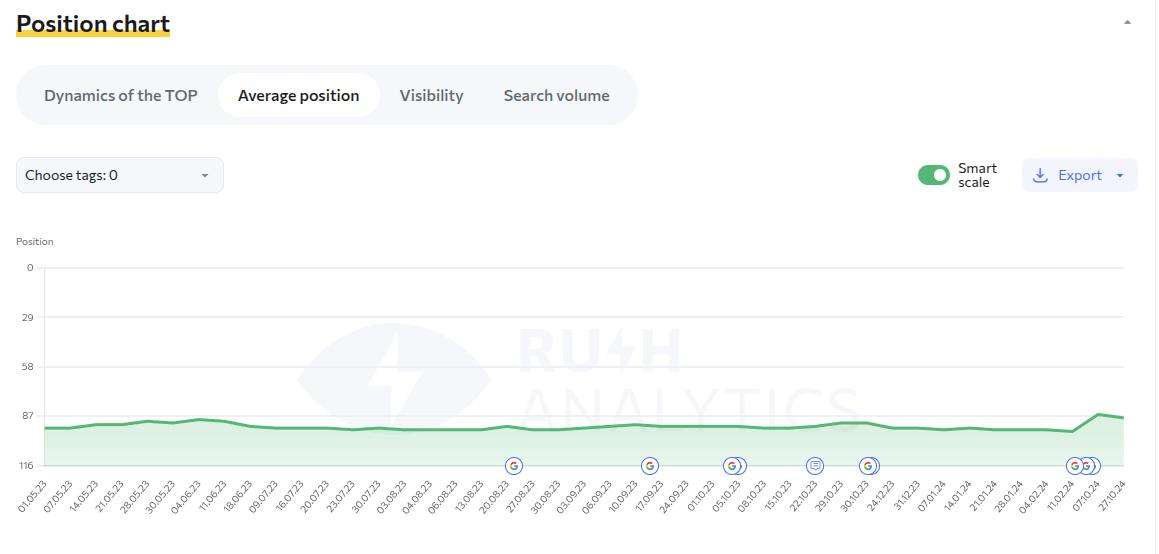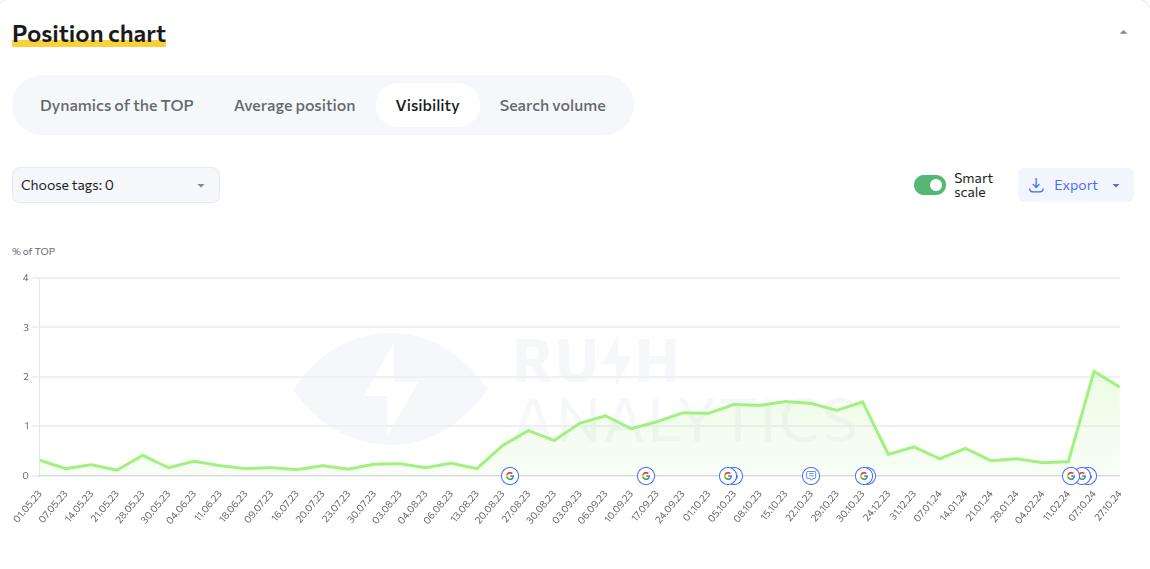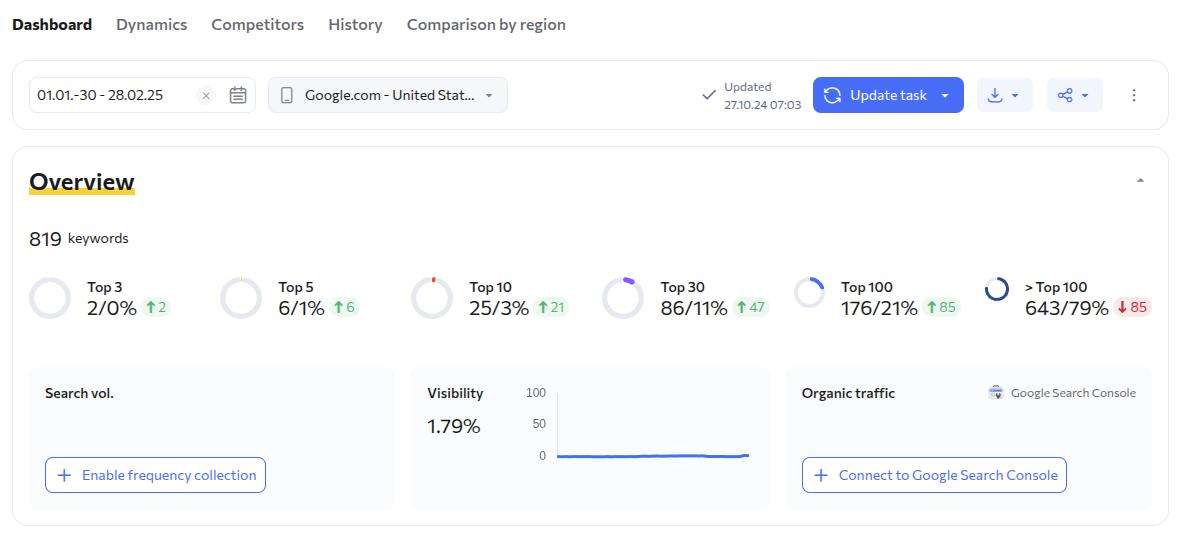SEO score is a term we hear a lot. In this post I’m going to explain what SEO score is, the different ways to calculate it and most importantly why it’s so important to keep an eye on it. I’ll also share some practical advice, tools you can use to check your SEO score and tactics you can use to increase your site’s visibility.
- What is SEO visibility?
- What affects your search visibility?
- How to check your search visibility?
- Track local and mobile SEO visibility
- What is a good SEO visibility score?
- How we calculate search visibility
- How to improve your search visibility?
- What to do if your site has visibility issues
- Conclusion
- SEO Visibility FAQ
What is SEO visibility?
An SEO visibility score is how visible your site is compared to hundreds of thousands of other keyword searches. Simple; if your site is near the top of the search results for a popular keyword that lots of people are searching for you have good SEO visibility. A visibility score can also be monitored over time to see if your site is getting easier or harder to find in the search engines.
What affects your search visibility?
Visibility within search should be simple to understand; it’s a measure of how visible your website is within Google or Bing. The main factors that affect it are:
Keywords: Keywords on your page help search engines understand what your page is about and rank for that query.
Good content: Content that helps users solve their problems builds your authority and relevance online and more opportunities for your pages to show.
Backlinks: The number of other well respected sites (pages) that link to your pages helps to boost your authority in the search engines (a vote of confidence)
User experience: A good user experience such as fast page speeds and mobile friendly pages can boost your rankings in search.
Technical optimization: Making sure your site is technically optimized and open to the search engine crawlers will improve your visibility in search.

How to check your search visibility?
There is a tool called Rush Analytics Rank Tracker that allows you to check your organic search visibility and keyword rankings in multiple locations, multiple languages. Plus you can use this tool to check search engine visibility and make informed decisions to optimize your SEO.
Just create a new task in the Rank Tracker, enter your domain and the keywords you want to track. Add keywords manually, upload from file or import from Google Search Console. Then select the search engines and locations you want to track.
After you’ve set your task, the tool will fetch the ranking data and show you the website visibility reports. The intuitive dashboard gives you a glimpse of the most important metrics like visibility score, average position, number of keywords ranking in top 10.

Go deeper into the data by visiting different tabs like Dynamics shows you the trend of your visibility and ranking over time, Competitors tab lets you compare your rankings with other competitor websites.

Track your search engine visibility regularly with Rush Analytics Rank Tracker, find areas for improvement, assess your SEO efforts, and increase your organic traffic.
Track local and mobile SEO visibility
Local and mobile SEO visibility tracking is one of the most important metrics for companies that care about their target audience. As mobile devices are more widespread than ever and local search is getting more important, you simply can’t ignore your website’s performance in these aspects.
Rush Analytics develops several tools that allow you to track your local and mobile SEO visibility. With our Local Rank Tracker, you can check your keyword rankings in selected cities and regions. This data might be helpful in getting insights into your local SEO performance. By reviewing these metrics you can fine-tune your local SEO activities and boost your visibility in local results.

In a similar way, our Mobile SERP Tracker gives you the ability to monitor your keyword rankings to mobile devices. Mobile search is ruling the internet these days and you should pay close attention to your website’s ranking to mobile devices as it’s a major driver of organic traffic and customer engagement. With this search engine visibility tool, you can discover improvement areas in your mobile SEO efforts and boost your visibility in mobile search results.

With these Rush Analytics SEO visibility check tools, you can get insights into your website’s performance in mobile and local results. By reviewing those metrics you can take actionable decisions and optimize your SEO efforts to boost your overall search visibility and deliver more qualified traffic to your site.
What is a good SEO visibility score?
There is no set rule for what constitutes a “good” visibility score. The important thing is to monitor your visibility score over a period of time. Rush Analytics allows you to compare your score with your competitors. This gives you a sense of how you fare in your industry.
As a rule of thumb, anything above 50% is quite good but remember your goal is to occupy some of the top positions on the first page of results for your most relevant keywords.
The visibility score is the proportion of possible search results that your website is visible for. This score is calculated out of the total number of possible search results. Hence a 100% visibility score will mean that your website is visible for every single relevant search result.
Useful data points that allow you to gauge the visibility of your website are provided by Rush Analytics Rank Tracker.
In the tool above, you will notice a dashboard that shows the overall visibility score of your website. This visibility score considers your keyword ranks, their search volumes and estimated click through rates. Hence you get a well rounded idea of how visible your site is in search engine results.
Remember, a high visibility score is not the sole indicator of success. Other complementary metrics like organic traffic, click through rates and conversions should be analyzed to have a full understanding of your SEO efforts.
By continuously tracking your website visibility score with Rush Analytics Rank Tracker and optimizing based on solid data, you can achieve a good SEO visibility score that brings results to your business.
How we calculate search visibility
At Rush Analytics, we know how important it is to have an accurate view of your website’s search visibility. Our Rank Tracker tool uses a complex algorithm to estimate your search visibility score to help you get insights into your SEO performance.

To calculate your search visibility, we consider the following important variables:
- Keyword ranks: For the list of keywords you select to track, we monitor your website’s ranks i.e. its positions in the SERPs.
- Search volumes: We integrate estimated monthly search volumes for each keyword in the tool. This way, high volume terms carry more weight in the overall calculation.
- Click through rates (CTR): Based on industry standard CTR models, we estimate the percentage of clicks your website is likely to get based on its rank positions.
After combining these three components, we get a search visibility score that indicates your overall presence and potential to attract organic traffic. This visibility score is represented as a percentage where a higher value indicates higher visibility in the search results.
Our calculation of search visibility should give you a metric that is meaningful and useful to track your SEO performance over time. By monitoring your search visibility score and looking at the data that drives it, you can make smart decisions to optimize your site and improve search engine performance.
How to improve your search visibility?
Do proper keyword research
Find relevant and high volume keywords that will best suit your business goals and target audience. Look for keyword opportunities using keyword suggestion tools like Rush Analytics Keyword Suggestion Tool and analyze the search volume and competitiveness of those keywords. Targeting the right keywords will allow you to optimize your content and raise your seo visibility scores in the search results for queries that are relevant to your business.
On-page optimization
Title tags, meta descriptions, header tags and body content on your site should be optimized for those keywords. Make titles and meta descriptions so good that users click on your listings in search results. And body content should be structured with header tags (H1, H2, H3) so search engines know what your web pages are about.
Create content that’s relevant and good
Search engines rank sites with content that means something, is informative and fun higher than those with no content or poor content. Not content for content’s sake, but topics your target audience will care about and add value to their business or personal lives. Do research, go deep and write clearly.
Keep your website constantly updated with fresh and relevant content to engage return visits from users and establish yourself as an industry expert.
Off-page optimization
Websites with high quality and relevant backlinks from reputable and authoritative sources are deemed to possess trustworthy and compelling content by search engines. Develop a backlink strategy to focus on building high quality and natural backlinks. Connect with industry influencers and guest post on relevant and authoritative websites. Create high quality resources that websites will be interested in linking to. And monitor your backlink profile using Rush Analytics Backlink Checker to warn and eliminate spam and low quality links that could negatively affect your search engine visibility.
Optimize for local search
If you have a local business, you need to optimize for local search. Get your business information (name, address, phone number) claimed and accurate across all online listings. Ask happy customers to leave reviews on your page and other review sites. Add local keywords to your content and meta tags so search engines know you’re relevant to local searches.
Speed and mobile-friendliness
Search engines love websites that provide a good user experience and that includes fast loading and mobile-friendly. Speed up your site by compressing images, code and caching. Be responsive and look good on all devices and screen sizes for mobile.
Monitor and analyze your search visibility
Use Rush Analytics Rank Tracker to watch your keyword rankings, visibility score and competitor performance. Analyze your organic traffic, click-through rates and conversion metrics to see how your SEO is working. Refine your strategies based on that data to stay one step ahead and maintain visibility.

What to do if your site has visibility issues
Search visibility is how visible your web pages are in search engine result pages (SERPs) for the keywords you’re targeting. If your visibility is dropping, you need to act fast, find the cause and fix it now. Let’s look at some steps to identify and correct the problems:
Perform a technical SEO audit
A website’s visibility can be greatly affected by technical SEO factors. You need to perform an exhaustive technical audit to find and fix all the problems that are affecting your website’s performance. Look for crawl errors, broken links, and indexing issues on your website. You can use tools like Rush Analytics SEO Audit Tool to check these issues.
Check your backlink profile
Checking your backlink profile is important to maintain high search exposure. You can use tools like Rush Analytics Backlink Checker to check your backlinks. Check for spammy, low-quality or irrelevant backlinks that may be pointing to your site and hurting your reputation. If you can’t remove those toxic backlinks through outreach, disavow them to prevent them from damaging your search ranking.
Check your keyword targeting
Poor keyword targeting can negatively affect your website’s search visibility. Check your keyword rankings and visibility (you can use Rush Analytics Rank Tracker).
Check your search visibility score
It is your website’s ability to be visible in search engines. If the score is low, your visibility is poor. Work on SEO, content and user experience to improve visibility. Watch out for search engine updates. Build traffic from various sources while maximizing visibility.
Check search metrics visibility
Another method of checking your visibility is to look at your search statistics. Search statistics represents how much traffic comes to your website via search engines. If the statistics are poor, it means that your site is not very visible.
Refresh your content for SEO
If you want to improve your search visibility score, you need to concentrate on your SEO. You need to refresh your website content with keywords that your visitors are looking for. This will help search engines to understand what your site is about and show it in relevant search results.
Watch out for search engine updates
Search engines like Google may roll out upgrades that could affect your website’s visibility. If your visibility score is dropping unexpectedly, one of those updates could be the culprit. Stay up to date with search engine updates.
Make your website user-friendly
Search engines are always looking to display user-friendly websites to their users. They prefer visitors to spend more time on a website that is easy to navigate and uses minimum effort to be readable. Secure that your website loads fast, works on smartphones and tablets and is easy to navigate. A user-friendly website can increase your Google visibility score.
Build traffic from other sources
As you work on your search visibility, you can also work on getting people to your site via other methods such as social media, emails, or ads. This will show that people are discovering and visiting your site.
It takes time and effort to improve your search visibility score but you need to be sure that you get more people visiting your site from search engines.
Get help
If you’ve tried everything above and still have visibility issues, get help from SEO professionals or agencies. They can give you expert advice, do deep audits and create custom strategies to improve your website’s visibility.
Remember, improving your search visibility score and overall SEO is an ongoing process. Monitor your visibility metrics with tools like Rush Analytics and make data driven decisions to fine tune your strategies. Stay on top of any issues that may be impacting your visibility score and keep providing value to your audience.
Now.
Done. 😊
(Just kidding, but I couldn’t resist!)
Get 7 days free trial access to all tools.
No credit card needed!

Conclusion
SEO visibility is a critical metric that indicates how easily users can find your website in search results. As we’ve explored throughout this article, understanding, measuring, and improving this metric requires a multi-faceted approach:
- Visibility measurement through specialized tools like Rush Analytics Rank Tracker provides valuable insights into your site’s search performance across different devices, locations, and keyword sets.
- Key influencing factors include properly researched keywords, high-quality content, authoritative backlinks, excellent user experience, and solid technical optimization.
- Improvement strategies focus on comprehensive keyword research, thorough on-page optimization, creating valuable content, building quality backlinks, optimizing for local search, and ensuring website speed and mobile-friendliness.
When visibility issues arise, a systematic approach to diagnosis and correction is essential—conducting technical audits, examining backlink profiles, reassessing keyword targeting, and monitoring search engine updates.
Remember that SEO visibility isn’t a static achievement but an ongoing process requiring regular monitoring and adjustment. By consistently tracking your visibility metrics and implementing data-driven optimizations, you can steadily improve your search presence, drive more qualified traffic to your website, and ultimately achieve better business results in an increasingly competitive digital landscape.
SEO Visibility FAQ
What is visibility check?
The visibility check is a measure of how frequently your website or particular web page appears in search results. You can check the visibility of your website to determine SEO success and measure online popularity. Visibility ratings are derived from your rankings for a given set of keywords. The higher the visibility, the more likely it is that a site will be discovered by visitors.
How to check SEO visibility?
Check your website SEO visibility with Rush Analytics Tools. Just put your domain name and tools will display the visibility graph over time. Along with that, it shows top keywords that are driving visibility. Rush Analytics tools show precise data to help you track your search visibility and improve it.
What is good visibility for SEO?
The good SEO visibility depends on the industry and the competition you face. However, on an average, if your visibility score is above 30-40% with Rush Analytics Tools, you are doing great. It indicates that your website is appearing in top search results frequently. You should keep improving visibility consistently by focusing on relevant keywords and quality content.
How can I check my SEO ranking?
Check your SEO ranking by utilizing keyword tracking in Rush Analytics Tools. Just put the keywords you are optimizing for and tools will show your website ranking in search results. You should track ranking over time to measure SEO performance. The objective should be to secure page one rankings (especially top 3).

